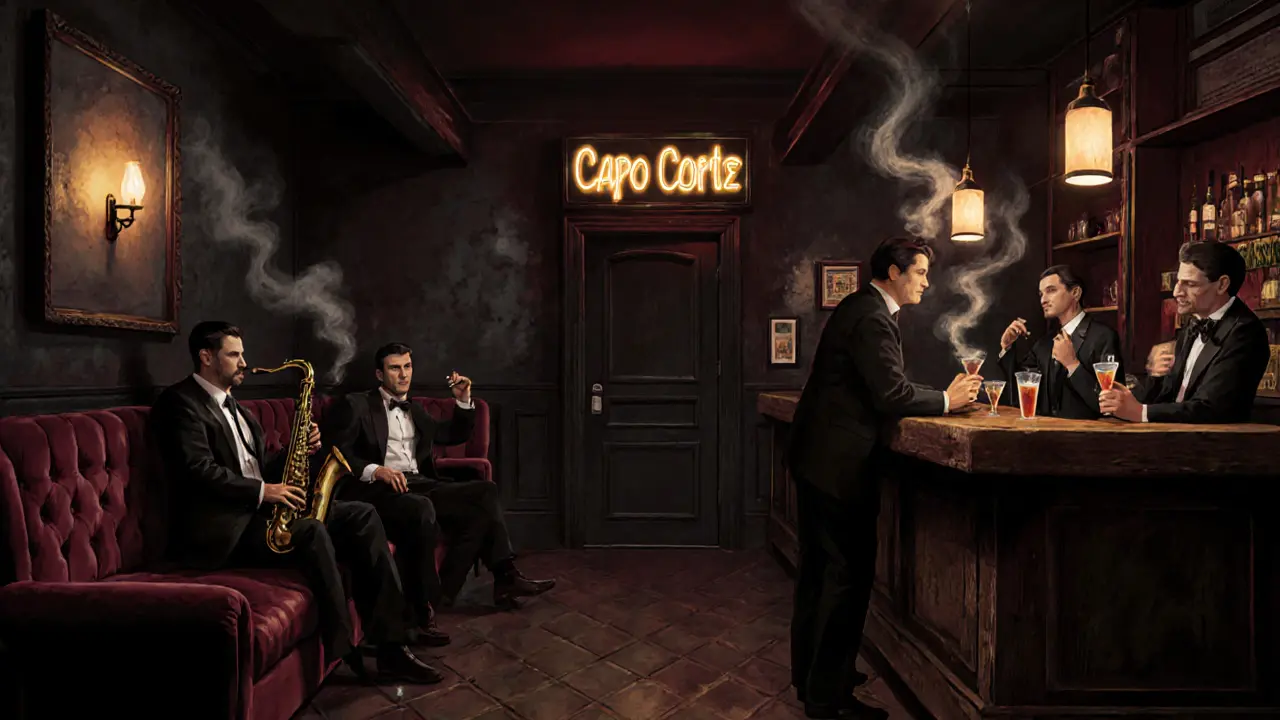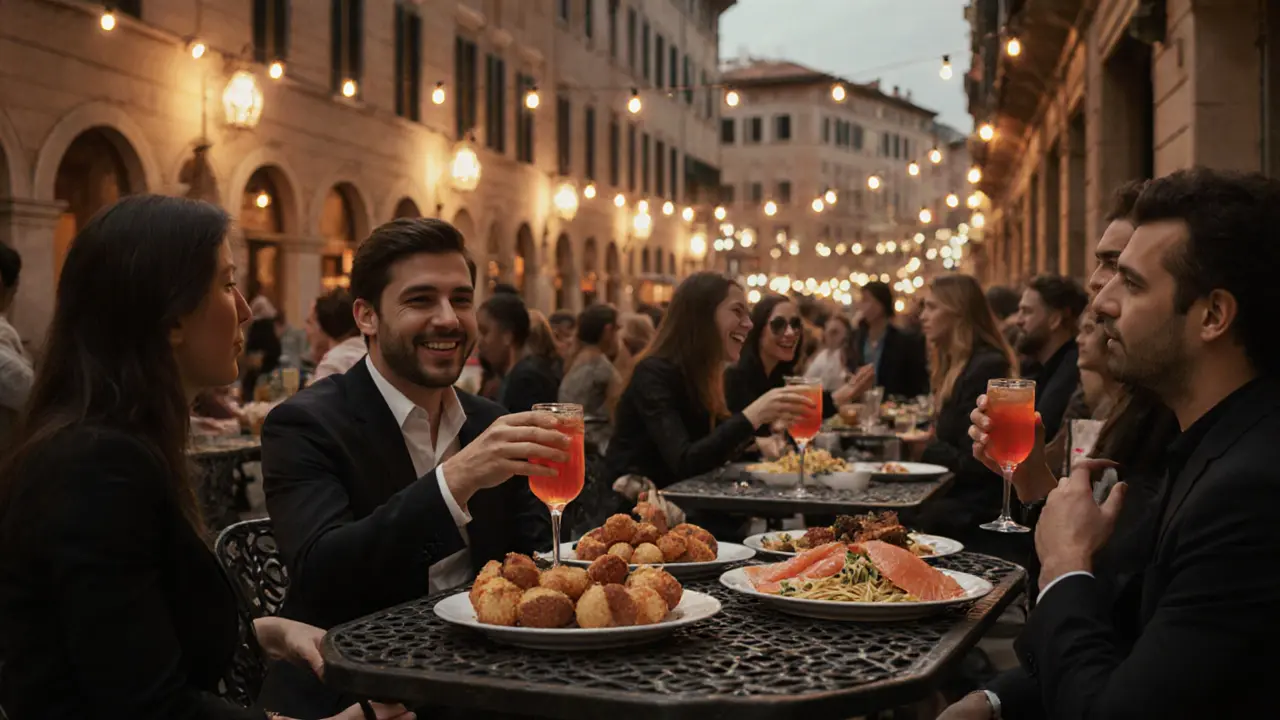Millions visit Milan for fashion, design, and art-but skip the nightlife at your own risk. By 10 p.m., the city doesn’t wind down. It wakes up. The streets fill with people in sharp coats, glasses clinking over Aperol spritzes, bass thumping from hidden courtyards, and laughter echoing off Renaissance facades. This isn’t just a city that has nightlife. It’s a city that lives it.
Start with Aperitivo-Milan’s Secret Nightlife Ritual
If you think nightlife means loud clubs and cover charges, you’re missing the heart of Milan. The real entry point? Aperitivo. It’s not a drink. It’s a ritual. Between 6 p.m. and 9 p.m., bars across the city turn into buffets. For the price of one cocktail-usually €10 to €15-you get unlimited snacks: mini sandwiches, truffle arancini, smoked salmon bites, fresh pasta, even risotto. It’s not a happy hour. It’s a pre-game feast.
Head to Terrazza Aperol in Brera. The terrace overlooks cobblestone alleys lined with art galleries. Order an Aperol spritz, grab a plate of burrata with cherry tomatoes, and watch locals mingle. This is where Milanese professionals unwind after work. No tourists. Just people who know.
For something more underground, try Bar Basso in the Porta Nuova district. It’s the birthplace of the Negroni Sbagliato. The bar’s been open since 1982. The stools are worn. The lighting is dim. And the staff won’t ask if you’re a tourist. They’ll just pour.
Where the Locals Go After Midnight
By 11 p.m., the Aperitivo crowd thins. The real party begins. And it doesn’t happen in tourist traps like Duomo Square. It happens in hidden courtyards, converted warehouses, and basements beneath antique bookshops.
Capo Corte is a cult favorite. You need a password. No, seriously. Text them on Instagram the day before. They’ll reply with a code. Walk through a nondescript door near Piazza XXV Aprile. Inside: a jazz band playing live, velvet couches, and a bar made from reclaimed wood. The crowd? Designers, musicians, and a few film directors who’ve worked with Paolo Sorrentino. No dress code. Just good energy.
If you want to dance, Magazzini Generali is your spot. It’s a former warehouse turned multi-level club. On weekends, they host international DJs-think deep house, techno, and experimental electronica. The sound system is built for bass you feel in your ribs. The crowd? Young, diverse, and totally unbothered by your shoes. You don’t need to look expensive. You just need to move.
For a more intimate vibe, try La Cucina di Lilli. It’s not a club. It’s a speakeasy-style bar tucked under a bakery. They only serve cocktails made with Italian herbs: rosemary gin, lavender vermouth, juniper-infused whiskey. The bartender will ask what mood you’re in. Then make you something you didn’t know you needed.
Districts That Define Milan’s Night
Not all of Milan’s nightlife is the same. Each neighborhood has its own rhythm.
- Brera: Romantic, artsy, and slow. Perfect for wine bars and quiet jazz. If you’re with someone you like, this is where you end up.
- Navigli: The canals light up after dark. Bars spill onto the water. Live acoustic sets. Picnic tables with string lights. It’s the closest thing Milan has to a European summer festival-year-round.
- Porta Ticinese: The grittier, edgier side. Think punk rock bars, underground vinyl shops, and late-night pizza joints that stay open until 4 a.m. This is where students and creatives go to be themselves.
- Porta Nuova: Sleek, modern, and high-end. Think rooftop lounges with skyline views and mixologists who treat cocktails like science. Best for business travelers who want to impress.
- Città Studi: The student district. Cheap beer, karaoke nights, and parties that start at 1 a.m. and end at sunrise. If you’re under 25 and want to meet locals, this is your zone.

What to Wear-No, Really
Milan doesn’t care if you’re rich. But it notices if you’re sloppy. You don’t need a suit. But you also don’t want to show up in sneakers and a hoodie unless you’re in Porta Ticinese.
Men: Dark jeans, a well-fitted shirt (no logos), and clean leather shoes. A light jacket is always a good move. Even in summer, the nights get cool.
Women: A little black dress works. But so does tailored trousers and a silk top. Heels? Optional. Comfort matters-Milan’s streets are cobblestone, and you’ll be walking.
Pro tip: Leave the baseball caps and flip-flops at the hotel. Milanese people dress like they’re always on a runway-even when they’re just grabbing a beer.
When to Go-Timing Is Everything
Milan’s rhythm is different from Rome or Naples. It’s not about late nights. It’s about layered nights.
Friday and Saturday are packed. But don’t go at midnight. Go at 11 p.m. Bars fill up slowly. The best spots don’t have lines-they have waiting lists. Book ahead if you want a table at Capo Corte or a spot on the rooftop at Terrazza 360.
Wednesday nights are surprisingly alive. Many bars host live music or themed nights. You’ll get better service. Fewer crowds. And sometimes, free entry.
Don’t show up before 9 p.m. unless you’re there for Aperitivo. Everything else is closed. Even the clubs. Milan doesn’t rush. It waits.

What Not to Do
- Don’t ask for a “Coke” at a bar. Say “Coca-Cola.” Or better yet, order a Spritz. It’s what locals drink.
- Don’t tip aggressively. Service is included. A €1-€2 extra is enough if you’re happy.
- Don’t take photos of strangers. It’s rude. Milanese people value privacy.
- Don’t assume all clubs are like Ibiza. Most are intimate, quiet, and focused on music-not flashing lights and bottle service.
- Don’t try to haggle on drinks. Prices are fixed. And they’re worth it.
Where to Eat After the Party
Most clubs close by 3 a.m. But the food doesn’t stop.
Trattoria Milanese on Via Tortona opens at 2 a.m. on weekends. Their risotto alla milanese is creamy, saffron-rich, and served with a glass of red wine. It’s the perfect reset.
Pizza al Taglio in Porta Ticinese serves slices by weight. Crispy crust. Thick tomato sauce. Fresh basil. €3 a slice. You’ll eat two.
And if you’re still up at 5 a.m.? Head to Caffè Cova. It’s been around since 1817. They serve espresso and brioche. Quiet. Elegant. And the last stop before dawn.
Final Tip: Don’t Rush It
Milan’s nightlife isn’t about checking off clubs. It’s about the spaces between. The conversation at the Aperitivo bar. The way the light hits the canal at midnight. The surprise of finding a jazz trio playing in a basement you didn’t know existed.
Slow down. Walk. Talk to strangers. Let the city lead you. You’ll leave with more than memories. You’ll leave with the rhythm of Milan in your step.
Is Milan nightlife safe at night?
Yes, Milan is one of the safest major European cities for nightlife. The main areas-Brera, Navigli, Porta Ticinese, and Porta Nuova-are well-lit and patrolled. Avoid isolated side streets after 2 a.m., especially near the train station. Stick to busy zones. Most locals walk home alone after midnight without issue.
Do I need to book ahead for Milan clubs?
For popular spots like Capo Corte, Magazzini Generali, or rooftop bars, yes. Book via Instagram or their website. Most clubs don’t charge cover on weekdays, but they do limit capacity. Walk-ins are welcome on Tuesdays and Wednesdays. Fridays and Saturdays? Plan ahead.
What’s the best night for nightlife in Milan?
Friday and Saturday are the busiest, but Wednesday nights are often the most fun. Many bars host live music, DJ sets, or themed parties with free entry. You’ll get better service, less crowding, and the same energy. If you can only pick one night, go Wednesday.
Are there any gay-friendly nightlife spots in Milan?
Absolutely. Milan is one of Italy’s most LGBTQ+-friendly cities. Bar Rosso in Brera is a long-standing gay bar with drag nights and cocktails. La Corte in Navigli is a mixed crowd with a welcoming vibe. And Club 12 near Porta Venezia is a full-on dance club with weekly themed parties. No judgment. Just good music.
Can I pay with card in Milan nightlife spots?
Most places accept cards now, especially in tourist areas. But always carry some cash. Smaller bars, especially in Porta Ticinese and Città Studi, still prefer euros. ATMs are everywhere, but avoid ones at train stations-they charge high fees.

